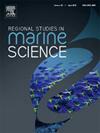Geochemical assessment of surface sediments in Tabarka's coastal ecosystem: An integrative analysis of trace metals and nutrient loading
IF 2.1
4区 环境科学与生态学
Q3 ECOLOGY
引用次数: 0
Abstract
In coastal Mediterranean regions the accumulation of contaminants in marine sediments is driven by the combined pressures of anthropogenic activities and environmental settings.This study investigates the influence of trace metals (TMs), total organic carbon (TOC), and nutrients, including total nitrogen (TN), from the El Kebir River on sediment quality in Tabarka's coastal ecosystem. In May 2024, we collected 24 surface sediment samples for geochemical and mineralogical analysis. The average concentrations of trace metals in the sediments were as follows: Fe (25,881 mg.kg⁻¹), Cu (9.45 mg.kg⁻¹), Zn (81.16 mg.kg⁻¹), Pb (35.70 mg.kg⁻¹), and Ni (44.45 mg.kg⁻¹). Average TOC content was 0.93 % while TN was only detected at riverine stations ranging from 0.3 % to 0.52 %. Pollution indices including the Pollution Load Index (PLI = 0.66), Contamination Factor (CF) for Pb = 1.78 (moderate contamination), Geoaccumulation Index (Igeo), and the ecological Risk Index (RI) = 10.14 (low ecological risk), indicated that the area can be classified from unpolluted to moderately polluted. The TN/TOC ratio suggests a mixed origin of terrestrial and marine organic matter where higher values (0.12 – 0.15) are likely due anthropogenic TN inputs. The Pearson correlation coefficient (r) analysis reveals good positive correlations (r > + 0.5) between trace metals and organic matter (TOC, TN), emphasizing the anthropogenic nature of this contamination. Principal component analysis (PCA) revealed two dominant sources of contamination linked to wastewater discharge and rainwater drainage. While results suggest moderate contamination level, continued accumulation of trace metals and nutrients could alter ecosystem functioning and exacerbate long-term ecological degradation.These findings emphasize the apparent need for urgent measures to improve wastewater treatment and pollution control to protect the coastal environment of Tabarka.
求助全文
约1分钟内获得全文
求助全文
来源期刊

Regional Studies in Marine Science
Agricultural and Biological Sciences-Ecology, Evolution, Behavior and Systematics
CiteScore
3.90
自引率
4.80%
发文量
336
审稿时长
69 days
期刊介绍:
REGIONAL STUDIES IN MARINE SCIENCE will publish scientifically sound papers on regional aspects of maritime and marine resources in estuaries, coastal zones, continental shelf, the seas and oceans.
 求助内容:
求助内容: 应助结果提醒方式:
应助结果提醒方式:


